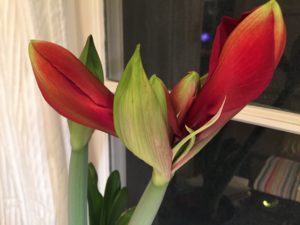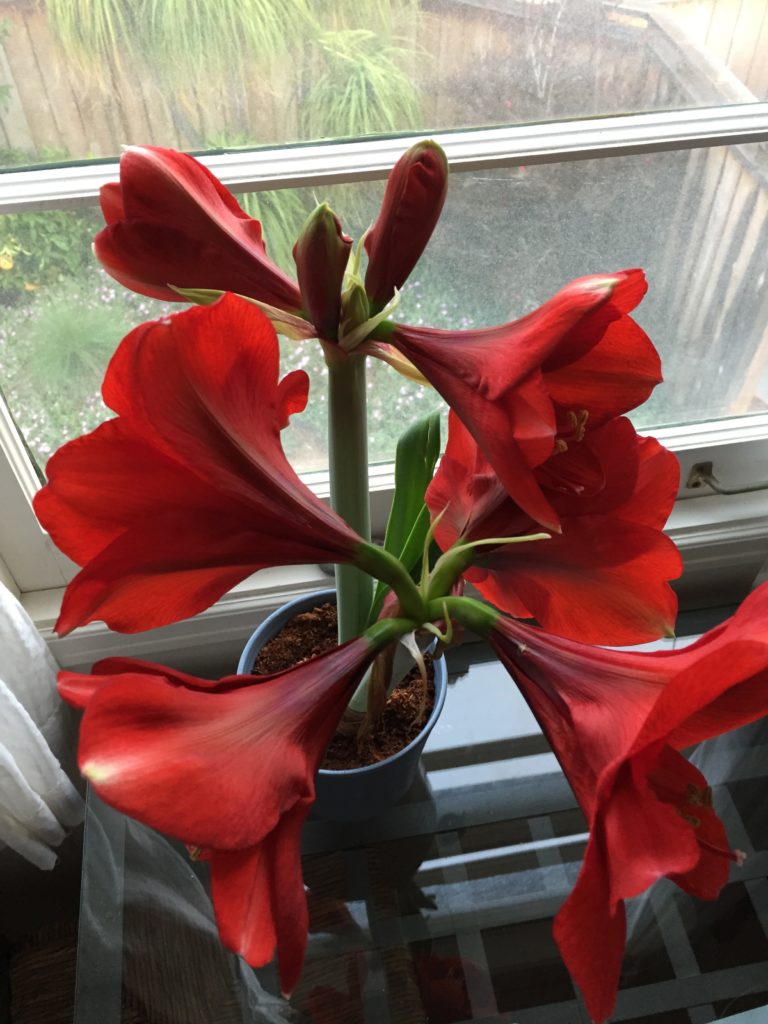 This is the second year my daughter-in-law gave me an amaryllis for Christmas. Maybe you got one too. They come all packaged up in a pretty box—a disk of potting soil, a large amaryllis bulb and a pot to grow it in.
This is the second year my daughter-in-law gave me an amaryllis for Christmas. Maybe you got one too. They come all packaged up in a pretty box—a disk of potting soil, a large amaryllis bulb and a pot to grow it in.
I followed the directions on the box, soaked the potting soil in water until it filled the pot then planted the bulb, pointy side down, and set the pot on my kitchen table where, each morning, I sit with my coffee and my notebooks and write.
These days I’m deep inside writing a memoir based on an around-the-world trip I took many years ago, after my husband died. I’m writing the notebook draft first, going to the blank page each morning and hoping to get down two or three or four pages. (Some mornings I settle for one.) It’s slow going. I think I might get discouraged at how long it’s taking me to get this first draft done, except for the amaryllis.
 For several mornings after I first planted the bulb I’d lean over the plant, coffee cup in hand, and examine it to see if anything had started growing yet. Nothing… nothing… nothing… until one day: voila! a tiny sprout of green showed itself. I was giddy with delight. Of course, all along things were going on underground: roots were digging deeper, finding their way. It’s like this with the writing: nothing… nothing… nothing… and then, one morning, voila! just like that: meaning appears and I experience the same giddiness. But before that cracking open of meaning can happen, there must be the digging deep, the work of finding the way.
For several mornings after I first planted the bulb I’d lean over the plant, coffee cup in hand, and examine it to see if anything had started growing yet. Nothing… nothing… nothing… until one day: voila! a tiny sprout of green showed itself. I was giddy with delight. Of course, all along things were going on underground: roots were digging deeper, finding their way. It’s like this with the writing: nothing… nothing… nothing… and then, one morning, voila! just like that: meaning appears and I experience the same giddiness. But before that cracking open of meaning can happen, there must be the digging deep, the work of finding the way.
Each of these winter mornings since planting the Amaryllis, I go through the same routine: examine the plant and rotate it toward the light, then light my candle, get out my notebook and pen, and settle in to write.
 Slowly, day by January and February day, the plant grew, leaves took shape, embryonic buds emerged. And day by day, in my notebook, the story grew, sentences took shape, paragraphs emerged. The Amaryllis and the memoir, both in the process of transforming.
Slowly, day by January and February day, the plant grew, leaves took shape, embryonic buds emerged. And day by day, in my notebook, the story grew, sentences took shape, paragraphs emerged. The Amaryllis and the memoir, both in the process of transforming.
Naturally, the cycle of the Amaryllis much shorter than the cycle of making a memoir, or a novel, or any long piece of writing. It will reach full bloom long before the memoir is complete. But for both, it’s still a matter of turning toward the light, digging deep, and allowing the process to shape what wants to emerge. Each must take as long as it takes.


Wonderful metaphor and wonderful you, seizing it and perservering for your memoir to bloom too.
Thanks Ellen. And while I’m still writing and writing (though not more than a few lines this morning), the beautiful, top-heavy Amaryllis tipped over from all that gorgeousness. She has been such an inspiring companion these last weeks. I hope she’ll stay a few more days.
This is a beautiful metaphor and a beautiful piece Judy! Thank you for the reminder.
Thanks for your comment, Laura. Lovely to see you here. I know you recognize the patience it takes–the writing and the flowering.
Dear Judy…. I love this! Reminds me of a poem i wrote a number of years ago…
This written to go with an Amaryllis bulb gift.
Amaryllis
There rests within the dark depth of winter
A bulb beneath the earth
Waiting for the longer day
The warmer sun
The softer rain.
It waits beneath the frosted crust
To break through and become
The radiant amaryllis.
Deep, deep darkness
Precedes a brilliant sun.
Hi Cary,
Thanks for posting this lovely poem. I saw it on the FB page and asked then if it was your poem. Now I see, yes yes it is and it so speaks to this flower that has been my winter companion. This morning I went to my writing/kitchen table to see that she’d tipped over from all her top-heavy gorgeousness.
I too love the winter amaryllis. My grandfather would have one and ever since, i have loved the idea of these winter flowers…
This is lovely. What a great metaphor!
Thanks for stopping by, Jill. I know you know about this, attuned to nature as you are. These mornings of late, I can almost hear the red explosions of the Amaryllis’s blooming. She’s a beauty. (so are you!)
Hey Judy,
Don’t forget to plant them in the ground and watch them multiply year after year!
Thanks Barb. If I had some “ground of my own,” I would do that. Meantime, I’ll cut them back and see if leaving them in the pot all year will allow them to come back next winter. Otherwise, I’m glad to share the bulb if you’d like to plant her.
Remember to add a bit of water maybe once a month, just a couple ounces to keep it alive.
My peace plants that I talked about in my book are gone after all the peace they lent to my writing space. One little plant, one huge urn, so they filled the urn. Then I overwatered them consistently. Bad Linda. Bad. Bad Linda.
I can’t wait to read your memoir (you are actually too young to write memoir you know).
Carry on, Teach!
Hi Linda,
I have that same tendency to overwater. I’ve lost a few ficus this way. But I’m trying to schedule the waterings, and also to check the leaves, check the soil, and talk to the plants. Sometimes they answer. (Thank goodness you’re here. Im dying of thirst.”)
Well, a memoir doesn’t have to be a whole life, you know. (I’m not done living it yet). I’m writing a memoir about a journey I took in 1990-91. Hope you like it, if/when it finally gets done and out there.
I meant to say the roots filled the urn, not the leaves. Sorry.
Thank you for sharing these particular words:
the timing is perfect!
Wishing you many of fulfilling writing morning rituals
with this deep red beauty and many future flowers and plants.
I bet they will both nurture and colour your stories.
Thank you so much for writing, and yes, keeping blooming flowers on my writing table does inspire and nurture (nature) my stories. I just visited your site, intrigued by “betweenlavenderandcoquelicots.” Thank you for the gorgeous photographs. I have a feeling I’ll visit often.
Many thanks Judy.- a deep thought, letting life and nature go at it’s own pace, not forced or coerced…..
“ Nikos Kazantzakis, author of Zorba the Greek and The Last Temptation of Christ, once wrote movingly about a chrysalis that he came across nestled in an olive tree. The infant butterfly, within its cocoon, was just starting to break through to greet a new life when Kazantzakis, anxious to shorten the natural process, breathed intensely on it. The butterfly eventually emerged, but because it was prematurely induced, its wings were insufficiently formed. Unable to take flight, the butterfly soon died. This intervention, in nature’s slow, unfolding of a life, gave Kazantzakis a stirring lesson to reflect upon. If he had let nature take its own course, if he had been more mindful and patient, the small butterfly would have felt the expression of life through its delicate wings, but because Kazantzakis impatiently intervened in a process that he did not fully understand, he had unintentionally denied this butterfly a life. “
Michael Lewin
http://www.michaellewin.org
Thanks for your comment, Michael. I really appreciate the Kazantzakis story. My neighbor/landlord has potted milkweed plants growing on his deck to attract the monarchs. Several times we’ve been able to watch, day-by-slow-day, as the tiny eggs turn to caterpillars, where they eat until finally hanging in that J shape, then the chrysalis form. Once, on a very patient morning, we got to see a monarch break through, and after a full day and night of fluttering up and returning to the safety of the plant, finally take wing, and off into the blue.
Judy if I wrote my memoir I would scare the people. Unfortunately I have a memory that reaches back to almost three years old so there’s lots to scare with. Now the amaryllis is another story.
I took a picture of one of those in my elderly neighbour’s apartment as she asked me to. When it was printed out I went to my writing café and my favourite table was ready, way in the front facing the street and the window sill. There was a red plant up there so I took the print with me to look at it and lookit dat! Same thing!
I wonder what the nonwriters were thinking. Likely the same as when I went right up to the cafe’s huge painting to see whether that was a grove of trees in the corner of the desert. Or a buffalo. Trees don’t have a beard but the beast did fool me.
Imagine a place where you can see amaryllis, buffalo, and a busy highway all at the same time.
Hi Linda,
A place where you can see amaryllis, buffalo, a busy highway, and a diligent writer, all at the same time. I love cafe writing.
I read your piece and made a few connections.
I had it my head a while ago to fertilize a seed I had in my head to see where it might lead.The seed was really my old, maybe not so fertile, trumpet — not a flower, by any means.
The poor thing had been ignored for 53 years, when I closed her case after playing taps at Officer Candidate School in Newport Rhode Island on a cold February morning in 1964.
[I’ll need to abbreviate the reacquaintance, only to say that] when I opened my trumpet case last year, it was like opening a casket where the flesh had been left unpreserved–perhaps not as bad as that.
The journey back to playing has been event-filled but as they say nowadays: “It’s all good.”
Hey Don,
Thanks for stopping by. The Amaryllis blossom does look a little like a trumpet, though, doesn’t it. Hope the tootling goes well. We miss you on Thursdays.